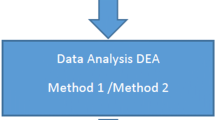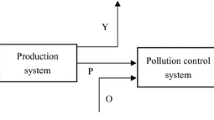Abstract
The widespread of sustainable development concept intimates a vision of an ecologically balanced society, where it is necessary to preserve environmental resources and integrate economics and environment in decision-making. Consequently, there has been increasing recognition in developed nations of the importance of good environmental performance, in terms of reducing environmental disamenities, generated as outputs of the production processes, and increasing environmental benefits. In this context, the aim of the present work is to evaluate the environmental efficiency of Italian provinces by using the non-parametric approach to efficiency measurement, represented by Data Envelopment Analysis (DEA) technique. To this purpose, we propose a two-step methodology allowing for improving the discriminatory power of DEA in the presence of heterogeneity of the sample. In the first phase, provinces are classified into groups of similar characteristics. Then, efficiency measures are computed for each cluster.
Access this chapter
Tax calculation will be finalised at checkout
Purchases are for personal use only
Similar content being viewed by others
Notes
- 1.
In order to individuate a significant number of efficient organisations, the literature suggests that the number of units has to be greater than 3(m+s), where m+s is the sum of the number of inputs and number of outputs (Dyson et al. 2001).
- 2.
k-means clustering requires the number of resulting cluster, k, to be specified prior to analysis. Thus, it will produce k different clusters of greatest possible distinction.
- 3.
Current scientific evidence links short-term NO2 exposures, ranging from 30 min to 24 h, with adverse respiratory effects including airway inflammation in healthy people and increased respiratory symptoms in people with asthma. Nitrogen dioxide also plays a major role in the atmospheric reactions that produce ground-level ozone or smog (Coli et al. 2011).
- 4.
Suspended particulate matter (SPM) is a mixture of particles of different size and state (solid and liquid) ranging from 0.01 μm to >10 μm in diameter: particles measuring <10 μm (PM10) penetrate into the lower respiratory system and might penetrate into the bloodstream. Particles may contain metals, such as zinc and nickel, organic materials and polycyclic aromatic hydrocarbons, some of which are carcinogenic (Coli et al. 2011).
- 5.
We have also tried to fix a larger number of clusters, but we have obtained clusters with a few units, and in this case DEA method cannot be applied with good results.
References
Aigner, D. J., Lovell, C. A. K., & Schmidt, P. (1977). Formulation and estimation of stochastic frontier production function models. Journal of Econometrics, 6, 21–37.
Banker, R. D., Charnes, A., & Cooper, W. W. (1984). Some models for estimating technical and scale inefficiencies in Data Envelopment Analysis. Management Science, 30(10), 78–1092.
Charnes, A., Cooper, W. W., & Rhodes, E. (1978). Measuring the efficiency of decision making units. European Journal of Operational Research, 2, 429–444.
Coelli, T. J. (1996). A guide to DEAP Version 2.1: A Data Envelopment Analysis program. CEPA Working Paper 96/08, University of New England, Armidale.
Coli, M., Nissi, E., & Rapposelli, A. (2011). Monitoring environmental efficiency: an application to Italian provinces. Environmental Modelling & Software, 26, 254–254.
Cooper, W. W., Seiford, L. M., & Tone, K. (2000). Data envelopment analysis, a comprehensive test with models, applications, references and DEA-solver software. Boston: Kluwer.
Dyckhoff, H., & Allen, K. (2001). Measuring ecological efficiency with Data Envelopment Analysis (DEA). European Journal of Operational Research, 132, 312–325.
Dyson, R. G., Allen, R., Camanho, A. S., Podinovski, V. V., Sarrico, C. S., & Shale, E. A. (2001). Pitfalls and protocols in DEA. European Journal of Operational Research, 132, 245–259.
Farrell, M. J. (1957). The measurement of productive efficiency. Journal of Royal Statistical Society Series A, 120, 253–281.
Johnson, R. A., & Wichern, D. W. (2002). Applied multivariate statistical analysis. Upper Saddle River: Prentice-Hall.
Kuosmanen, T., & Kortelainen, M. (2005). Measuring eco-efficiency of production with data envelopment analysis. Journal of Industrial Ecology, 9, 59–72.
Samoilenko, S., & Osei-Bryson, K. (2008). Increasing the discriminatory power of DEA in the presence of the sample heterogeneity with cluster analysis and decision trees. Expert Systems with Applications, 34, 1568–1581.
Samoilenko, S., & Osei-Bryson, K. (2010). Determining sources of relative inefficiency in heterogeneous sample: methodology using cluster analysis, DEA and neural networks. European Journal of Operational Research, 206, 479–487.
Scheel, H. (2001). Undesirable outputs in efficiency valuations. European Journal of Operational Research, 132, 400–410.
Seiford, L. M., & Zhu, J. (2005). A response to comments on modeling undesirable factors in efficiency evaluation. European Journal of Operational Research, 161, 579–581.
Thanassoulis, E. (1996). A data envelopment analysis approach to clustering operating units for resource allocation purposes. Omega-The International Journal of Management Science, 24, 463–476.
Thore, S. A., & Freire, F. (2002). Ranking the performance of producers in the presence of environmental goals. In S. A. Thore (Ed.), Technology commercialization: DEA and related analytical methods for evaluating the use and implementation of technical innovation. Boston: Kluwer.
Author information
Authors and Affiliations
Corresponding author
Editor information
Editors and Affiliations
Rights and permissions
Copyright information
© 2013 Springer International Publishing Switzerland
About this paper
Cite this paper
Nissi, E., Rapposelli, A. (2013). Performance Measurement of Italian Provinces in the Presence of Environmental Goals. In: Giudici, P., Ingrassia, S., Vichi, M. (eds) Statistical Models for Data Analysis. Studies in Classification, Data Analysis, and Knowledge Organization. Springer, Heidelberg. https://doi.org/10.1007/978-3-319-00032-9_29
Download citation
DOI: https://doi.org/10.1007/978-3-319-00032-9_29
Published:
Publisher Name: Springer, Heidelberg
Print ISBN: 978-3-319-00031-2
Online ISBN: 978-3-319-00032-9
eBook Packages: Mathematics and StatisticsMathematics and Statistics (R0)




